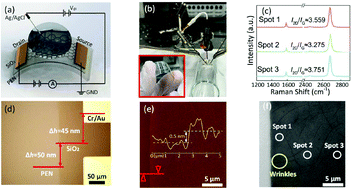Our official English website, www.x-mol.net, welcomes your feedback! (Note: you will need to create a separate account there.)
Measurement of cytokine biomarkers using an aptamer-based affinity graphene nanosensor on a flexible substrate toward wearable applications†
Nanoscale ( IF 6.7 ) Pub Date : 2018-10-26 00:00:00 , DOI: 10.1039/c8nr04315a Zhuang Hao 1, 2, 3, 4, 5 , Ziran Wang 1, 2, 3, 4, 5 , Yijun Li 1, 2, 3, 4 , Yibo Zhu 1, 2, 3, 4 , Xuejun Wang 1, 2, 3, 4 , Carlos Gustavo De Moraes 2, 3, 4, 6 , Yunlu Pan 5, 7, 8, 9 , Xuezeng Zhao 5, 7, 8, 9 , Qiao Lin 1, 2, 3, 4
Nanoscale ( IF 6.7 ) Pub Date : 2018-10-26 00:00:00 , DOI: 10.1039/c8nr04315a Zhuang Hao 1, 2, 3, 4, 5 , Ziran Wang 1, 2, 3, 4, 5 , Yijun Li 1, 2, 3, 4 , Yibo Zhu 1, 2, 3, 4 , Xuejun Wang 1, 2, 3, 4 , Carlos Gustavo De Moraes 2, 3, 4, 6 , Yunlu Pan 5, 7, 8, 9 , Xuezeng Zhao 5, 7, 8, 9 , Qiao Lin 1, 2, 3, 4
Affiliation

|
We present an approach for the label-free detection of cytokine biomarkers using an aptamer-functionalized, graphene-based field effect transistor (GFET) nanosensor on a flexible, SiO2-coated substrate of the polymer polyethylene naphthalate (PEN). The nanosensor conforms to the underlying nonplanar surface and performs GFET-based rapid transduction of the aptamer–biomarker binding, thereby potentially allowing the detection of cytokine biomarkers that are sampled reliably from human bodily fluids (e.g., sweat) in wearable sensing applications. In characterizing the suitability of the nanosensor for wearable applications, we investigate the effects of substrate bending on the equilibrium dissociation constant between the aptamer and the biomarker as well as the graphene transconductance. The utility of the nanosensor is demonstrated by the detection of tumor necrosis factor-α (TNF-α), an inflammatory cytokine biomarker. Experimental results show that the flexible nanosensor can specifically respond to changes in the TNF-α concentration within 5 minutes with a limit of detection as low as 26 pM in a repeatable manner.
中文翻译:

使用基于适体的亲和性石墨烯纳米传感器在柔性基底上针对可穿戴应用的细胞因子生物标记物的测量†
我们提出了一种在聚合物聚萘二甲酸乙二醇酯(PEN)的柔性,SiO 2涂覆的基底上使用适体功能化的,基于石墨烯的场效应晶体管(GFET)纳米传感器对细胞因子生物标志物进行无标记检测的方法。纳米传感器符合下面的非平面表面,并执行基于GFET的适体-生物标记物结合的快速转导,从而潜在地允许检测从人体液中可靠采样的细胞因子生物标记物(例如(汗水)在可穿戴传感应用中。在表征纳米传感器对可穿戴应用的适用性时,我们研究了基板弯曲对适体和生物标记之间的平衡解离常数以及石墨烯跨导的影响。通过检测炎性细胞因子生物标志物肿瘤坏死因子-α(TNF-α),证明了纳米传感器的实用性。实验结果表明,这种柔性纳米传感器可以在5分钟内特异性地响应TNF-α的变化,并且可重复的检测限低至26 pM。
更新日期:2018-10-26
中文翻译:

使用基于适体的亲和性石墨烯纳米传感器在柔性基底上针对可穿戴应用的细胞因子生物标记物的测量†
我们提出了一种在聚合物聚萘二甲酸乙二醇酯(PEN)的柔性,SiO 2涂覆的基底上使用适体功能化的,基于石墨烯的场效应晶体管(GFET)纳米传感器对细胞因子生物标志物进行无标记检测的方法。纳米传感器符合下面的非平面表面,并执行基于GFET的适体-生物标记物结合的快速转导,从而潜在地允许检测从人体液中可靠采样的细胞因子生物标记物(例如(汗水)在可穿戴传感应用中。在表征纳米传感器对可穿戴应用的适用性时,我们研究了基板弯曲对适体和生物标记之间的平衡解离常数以及石墨烯跨导的影响。通过检测炎性细胞因子生物标志物肿瘤坏死因子-α(TNF-α),证明了纳米传感器的实用性。实验结果表明,这种柔性纳米传感器可以在5分钟内特异性地响应TNF-α的变化,并且可重复的检测限低至26 pM。


























 京公网安备 11010802027423号
京公网安备 11010802027423号